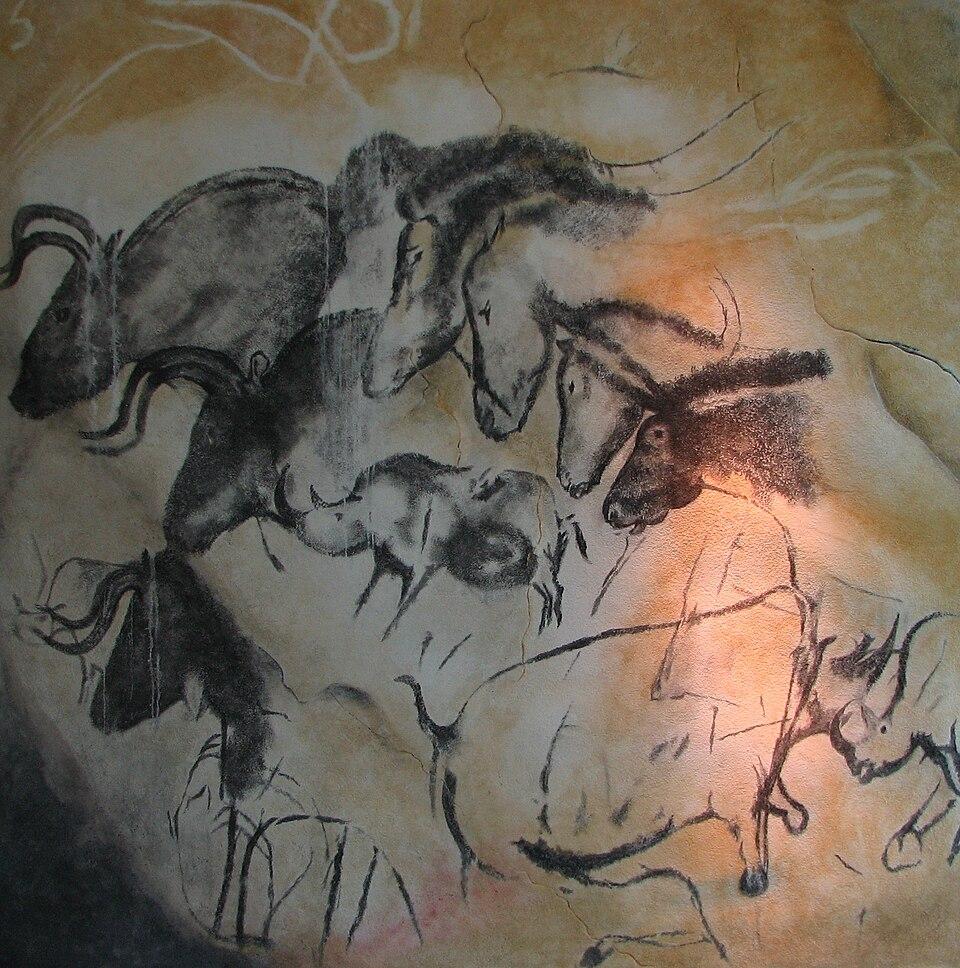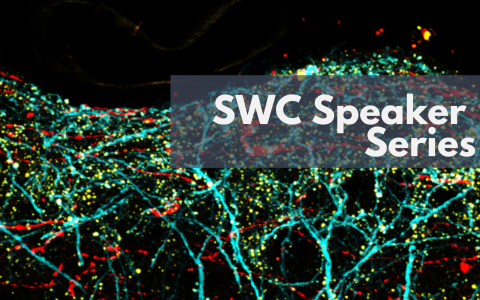
What makes us human?
Dr Franck Polleux, based at Columbia University, is studying the unique properties of the human brain. How does it develop? How did we evolve? What makes us different from other species? Following his recent seminar at SWC, Franck sat down with us to discuss his work and interests, spanning from cave paintings to genetics.
Could you tell us the key questions that you are addressing in your work?
There are two central questions. One is a general question - how do neurons wire up during development? We're trying to probe that. We are also trying to identify the function of genes that control neural development and those that control the ability of neurons to receive and integrate inputs.
The second question is to ask essentially the same, but with an evolutionary angle. We're very interested in identifying what makes us human. What's different about the human brain in particular?
How are you tackling such big questions?
We're taking a genetic approach. Mapping the human genome 15 years ago meant that scientists became able to identify portions of DNA sequences that are only found in the human genome. About 1% of the human genome sequence isn’t found in any other mammals, including great apes. This 1% contains about 80 protein-coding genes, which can be grouped into 30 gene families of similar, related genes. Some of these human-specific genes have been duplicated multiple times.
We were among the first labs to ask what those genes are doing. We focused mostly on one of these - SRGAP2. We've been studying this gene for 15 years now. I think it's one of the best-understood examples of what human-specific genes do during brain development.
How do your findings on SRGAP2 help explain what makes the human brain special?
All mammals have a version of this gene - it is highly conserved. But only humans have multiple extra copies. The way I tell the story of SRGAP2 is completely retrospective - we didn't know anything about what the extra copies of this gene do when we first set out!
We started to study SRGAP2 in 2009, and quickly discovered its functions. It codes for a protein located at synapses, the connections between neurons which mediate the flow of information through neural circuits, and is also required for neuronal migration and neuronal morphology1.
The second thing we discovered is that the multiple extra copies found in the human genome inhibit the function of the ancestral copy of the gene2.
So, what have we learned about the human brain? Once we knew about the function of the gene, we explained those changes by saying they're human-specific. Though it makes sense now, at the time, we had no idea of the consequences of having multiple copies of SRGAP2.
However, what was known at the time was that essentially two things distinguish human neurons from any other species.
The first one is that our synapses mature exceedingly slowly compared to other mammals including great apes. You don't get a full number of mature synapses until 10 to 15 years after birth in the human cortex. Biologically, it's an incredibly protracted period of development – a phenomenon called neoteny.
And the second thing that we know about human neurons is that we have approximately twice as many synapses per neuron as any other non-primate neurons, including great apes.
So humans have increased connectivity, and these synaptic connections are exceedingly slow to emerge and mature. And we showed that the human-specific copies of SRGAP2 play a critical role in both neoteny and increased connectivity3.
Although, to this day, we don't know what neoteny is good for. Why did nature select the human brain to be so slow at developing? There have been hypotheses and conjectures. People have described critical periods during brain development as the period of after birth when we are more able to learn. So the idea is that by prolonging the timing of synaptic maturation, critical periods of increased learning might be extended. But in a sense, we have no idea. It is only very recently that we have had a way to actually manipulate neoteny in mice4. And so we can now study what happens if you induce neoteny and increase synapse connections.

What were the consequences of altering SRGAP2 in mice?
We confirmed that extra copies of the gene did induce neoteny and increase neuronal connectivity when introduced in mouse neurons. Just introducing one copy of the human-specific SRGAP2 is sufficient to increase cortical connections, change circuit properties in the cortex in very interesting ways. Neurons become, essentially, better sensory coders.
They are more specific in their response properties to sensory stimulation, they're less noisy. And this has a significant impact at their ability to learn: those mice become remarkably better at learning a complex task that control mice can hardly learn.
The second thing that we learned is through the reverse experiment. The dream experiment was actually to delete those human-specific SRGAP2 genes in human neurons, to see what happens. But obviously this was impossible until very recently.
But what we have been able to do, with our collaborator Dr. Pierre Vanderhaeghen from VIB-KU Leuven in Belgium, is introduce human neurons, derived from pluripotent stem cells, into the brain of mouse neonate, via a process called xenotransplantation. There are just a few human neurons in a mouse brain, but they fully develop and integrate into the mouse brain circuits.
It's remarkable how fully integrated those neurons are. We think that for the first time ever we have ways to study structural and functional development of human neurons, in a living system, in an intact circuit. This is a complete game changer.
In this context, using this technique for the first time, we've been able to knock out the human-specific copies of the gene, and as expected, this massively accelerates synaptic development5.
Now we're looking at the functional consequences of accelerating synaptic development in human neurons.
This work has implications for understanding neurodevelopmental disorders – could you tell us more about that?
I think the probably the most important thing we learned in this context is that we discovered that how this protein regulates synaptic development at the molecular level.
SRGAP2 promotes synaptic maturation by inhibiting the function of another, more famous synaptic protein called Syngap1, which exerts the reverse effect, it slows down synaptic maturation. Syngap1 is very frequently mutated in autism spectrum disorders and intellectual disability. We discovered that the consequence of mutating Syngap1 is, essentially, human-specific, because its function is modified by the presence of human-specific copies of SRGAP2.
The take-home message of this I think, is profound. It suggests for the first time that those human-specific genes are not only relevant to human evolution, but they can act as human-specific disease modifiers, explaining why some genetic mutations do not have the same consequences, or phenotypes, in humans than in model organisms often used in biomedical research such as mice.
What was the most surprising thing you’ve found?
The strength of the effects of this gene. A single extra copy of SRGAP2 in this context can have a big impact on both the timing of synaptic development and the total number of synapses received by individual neurons. Increasing anything by 50% in biology is very rare! For most traits, they are modified a tiny amount by hundreds of different genes.
Finding such a large effect is very rare. Either we got lucky, or this could be an effect of other human-specific gene duplications, too. Perhaps they were selected for, in evolution, because they are powerful modifiers. But we just don’t know, yet.
Do you think we'll ever be able to explain human-specific traits like language, creativity or consciousness in genetic terms?
I don't know. That's a tall order. Consciousness and language are traits that are probably regulated by hundreds or thousands of genes. So it's hard to say. Plus, language has emerged multiple times during evolution. For example, some birds have an incredible capacity for vocal communication. Some species do it in a completely innate way, others in a completely learned way. Language is amazing but it's not unique to humans.
I don't think consciousness is human-specific, either. Though there's a whole debate about this. Consciousness as in awareness of your self-representation and the fact that you can talk or think about what you're doing in the context in the larger context of non- self - I'm sure many other species can do this.
So really, the question is, what does make us different? That is a big question, and I’m not sure whether we'll ever explain it with purely genetic approaches.
But I think we can probably point to a couple of traits of brain development or adult brain function that might be human-specific. Like the fact that we are remarkably slow to develop. Now we can manipulate that, maybe we will find it leads to the emergence of complexity in circuits. Having access to those genes is allowing us to understand that.
Creativity is a trait I would argue is specific to humans. Humans are amazing at building abstract, sometimes artistic, representations of the world. Part of my fascination with studying these questions comes from some cave paintings I visited when I was younger. The most famous, though this is unfortunately not accessible, is located at Chauvet-Pont-d'Arc Cave in France. The paintings in this cave date from 37 to 35,000 years ago.
This cave seems to have been visited by humans for over a thousand years, probably closer to 2000 years. Some of the paintings are 1000 years apart. So people came back to this cave over and over again. What's remarkable is the quality of the representations of fauna at that location at that time – they are amazing.
37,000 years ago, people were probably struggling to survive in a very hostile environment and they still had the drive to go into this kilometre-long cave in total darkness to paint on walls. That I find truly remarkable.
Of course, it isn’t known if these cave paintings are purely representational, or if they had another role, perhaps in a cult, or maybe to help with hunting. The depiction of the movement of the animals is truly fascinating. The level of abstraction goes beyond simply depicting the world. The film director Werner Herzog who had unique access to the Chauvet cave to make a documentary called the Cave of Forgotten Dreams, remarked that some of these drawings represent animals in movement, a sort of ‘proto-cinema’.
I find this amazing. I think creativity is a human trait that evolution has shaped using increase in cognitive abilities. So how did this emerge during evolution? Can we ever study this? I don't know. What is the neural basis for this in the brain? Can you modify it? Perhaps we will never know. But I think we can approach some of these questions now.

Replica of the painting from the Chauvet cave, in the Anthropos museum, Brno. The original art is approximately 31,000 years old, probably Aurignacien. The group of horses probably does not picture a herd of them, but some kind of etiological study, showing, from left to right, calmness, aggression, sleep and grazing.
What are the next big questions that you are looking at?
We're obviously only scratching the surface on the genetic basis of human brain evolution. So we, and others - there is now a whole field using this paradigm - are always looking for new genes in that human-specific list, trying to identify what those genes modify. So that's a big focus of our lab.
We're also very interested in more general questions outside the context of human evolution about the molecular basis of synaptic plasticity and learning.
The brain is very complex. You can study the brain at so many different scales, right from molecules to synapses, to neurons to circuits to behaviour and everything in between. Bridging those gaps is very challenging experimentally and conceptually because the people who do this work tend not to speak the same scientific language.
One of the challenges of modern neuroscience is to find ways, through collaborations or other paths, to cross those bridges. We need to combine those different levels of analysis because ultimately, if we want to understand how the brain develops or how it functions, we're going to need to understand this system at all scales, not a single one at a time.
It’s difficult, but we're trying hard to do that. And despite the challenges, it’s also a lot of fun.
Further reading and references
1. https://pmc.ncbi.nlm.nih.gov/articles/PMC2797480/
2. https://pmc.ncbi.nlm.nih.gov/articles/PMC3357949/
3. https://pmc.ncbi.nlm.nih.gov/articles/PMC11230448/
4. https://pubmed.ncbi.nlm.nih.gov/36792753/
5. https://pubmed.ncbi.nlm.nih.gov/39406239/


